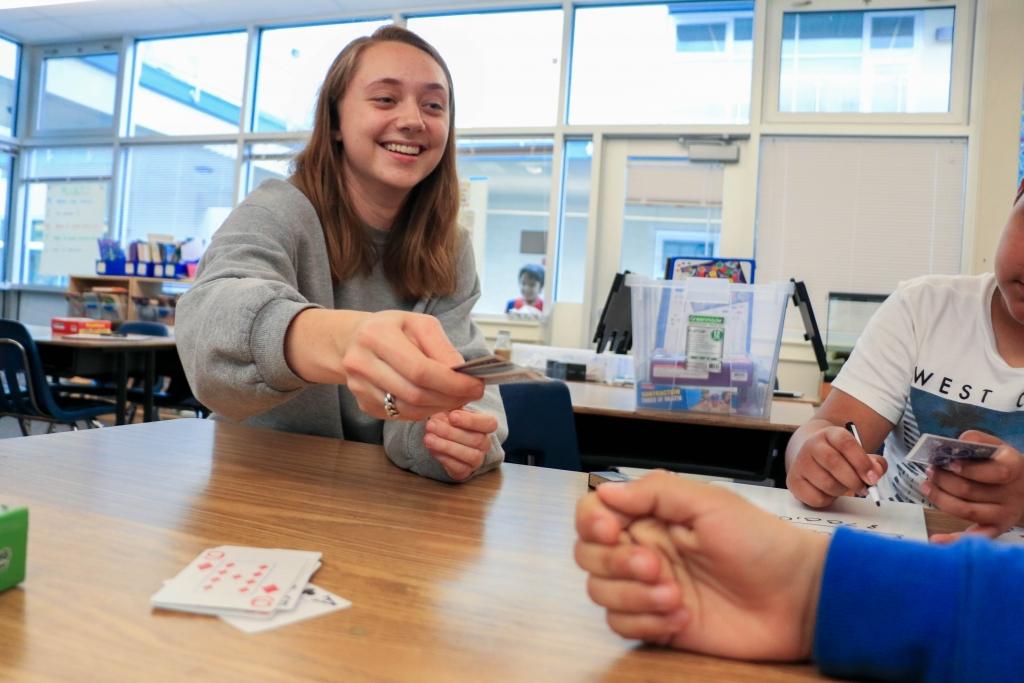As she gathers a group of second graders onto the colorful rug, Palo Alto High School senior Lucy Volino smiles while prompting each of them to introduce their name and favorite ice cream flavor before reciting the names of everyone before them. Keeping elementary schoolers excited about math is no easy feat, especially on a Friday afternoon, but Volino makes it look easy as the rambunctious kids cling onto her every word.
While the kids stumble over the names of the other volunteers, each one repeats “Lucy” without hesitation, a testament to the impact Volino has had on the lives of kids who attend Buddies4Math, an after-school program which inspired the creation of her science program, Stellar.
Stellar is a science program for at-risk youth who attend Mariano Castro Elementary School in Mountain View and need extra help with homework or after school supervision. Each Tuesday, kids who stay after school with the local YMCA program conduct hands-on activities that help them develop a strong foundation in the physical sciences. As the founder and program head, Volino plans curriculum, coordinates volunteers and leads Stellar sessions every week.
“Stellar has been a way for students to get more enjoyment out of science,” Volino says.
Volino began planning this science education program when she was just a sophomore. Her vision for the program was inspired by her volunteer work at Buddies4Math, a similar after-school education enrichment program she has volunteered with since seventh grade.
One of the things that frustrates me most is seeing inequality persist in … both the educational system and the world as a whole.”
— Lucy Volino, senior
Through Buddies4Math, Volino says she saw a vast disparity in access to learning resources between Palo Alto elementary schools and Mariano Castro elementary school, prompting her to start a program of her own. After hearing about the lack of exposure to science for elementary school students and reflecting on her own positive experience with science, she went forward with Stellar.
“One of the things that frustrates me most is seeing inequality persist in various forms in both the educational system and the world as a whole,” Volino says. “Stellar allows me to play a small part in lessening that inequality.”
The evolution of Stellar
After some encouragement from her former science teacher Alicia Szebert, Volino reached out to Beyond the Bell, an organization that runs after-school educational programs including Buddies4Math. However, when they stopped communicating with her after a few months, she ultimately connected with the Palo Alto YMCA, which agreed to work alongside Volino to implement Stellar.
Once Volino was ready to launch Stellar, she says she faced the challenge of finding consistently committed volunteers.
“I want people who are familiar with the kids and familiar with the program so that we have a really strong group of people to work with the kids,” Volino says.
Luckily, Volino was able to connect with volunteers from Khan Lab School, a local independent school, and even some from Paly through word of mouth.
Senior Anna Oft has volunteered at Stellar since its inception and says she enjoys working with Volino and watching the kids grow.
“All of the elementary schoolers like it a lot and you can tell they [the kids] are excited,” Oft says. “You can tell that Lucy really cares about the kids and their learning by the way she works with them and interacts with other volunteers.”
Through experiencing Stellar’s ups and downs, Volino says she has learned both practical skills like grant pitch writing and communication skills she’ll carry with her to college and beyond.
“I have gotten to better understand how becoming familiar with a community and a set of people in a place can be really valuable,” Volino says.
Catalyzing growth
Volino creates Stellar’s curriculum each semester and bases it on Next Generation Science Standards — California’s public school science curriculum guidelines. Each week’s activities are planned months in advance so she has time to order all the necessary supplies using grant money. Then, each weekend, she puts together the materials for the week ahead.
“Luckily we live in the Bay Area — there are a lot of companies and people that are giving out money to individuals who are working in education or just service projects in general,” Volino says.
“If students are excited about learning and excited about what they can do with science, it [the achievement gap] will improve”
— Lucy Volino, senior
Just recently, Volino put together an activity that taught the elementary schoolers about the solar system by painting styrofoam balls to build a model of it.
She says the kids responded especially well to this activity, as it gave them the chance to combine learning science in an upbeat, fun environment — the epitome of Stellar’s program goals.
According to Volino, by teaching science in a way that is enjoyable to the kids, Stellar helps instill a passion for science from a young age. By doing so, the program helps bridge the very prominent achievement gap in the education system.
“Any way schools or other organizations help encourage passion for STEM … is really important, because a lot of times it takes both teachers and students to improve the achievement gap,” Volino says. “If students are excited about learning and excited about what they can do with science, it will improve.”
The next phase
As of now, the future of Stellar is uncertain as Volino, the program’s leader from its humble beginnings, will graduate this year. However, Volino plans to pass her position onto one of the many dedicated volunteers.
“I hope that Stellar will continue to be a sustainable resource for the community to foster a larger number of students who are passionate about learning, passionate about science and passionate about what they themselves can achieve in STEM,” Volino says.



